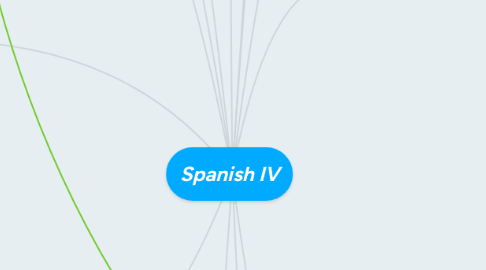
1. Por vs Para
1.1. Idioms
1.1.1. Por eso
1.1.2. Por fin
1.1.3. Por lo general
1.1.4. Por lo menos
1.1.5. Por otra parte
1.1.6. Por supueto
1.2. Por
1.2.1. Reason
1.2.2. Cause
1.2.3. Period of Time
1.2.4. Through something
1.2.5. Imprecise Location
1.2.6. Means of Communication / Transportation
1.2.7. Exchange
1.2.8. Indicating Substitutions
1.3. Para
1.3.1. Destination
1.3.2. In order to
1.3.3. Deadline
1.3.4. Comparison to Norm
1.3.5. Indicate Employer
1.3.6. To / for whom
2. Knowing/Familiarizing
2.1. Saber
2.1.1. When To Use
2.1.1.1. To Know Facts
2.1.1.2. To Know How To...
2.1.1.3. Preterite: To Have Found Out
2.1.2. Conjugations
2.1.2.1. Sabemos
2.1.2.1.1. Sé
2.1.2.2. Sabéis
2.1.2.2.1. Sabes
2.1.2.3. Saben
2.1.2.3.1. Sabe
2.2. Conocer
2.2.1. When To Use
2.2.1.1. Being Familiar with
2.2.1.2. Knwoing a Person
2.2.1.3. Having Expierence
2.2.2. Conjugations
2.2.2.1. Conocemos
2.2.2.1.1. Conozco
2.2.2.2. Conocéis
2.2.2.2.1. Conoces
2.2.2.3. Conocen
2.2.2.3.1. Conoce
3. Articulos
3.1. Indefinite
3.1.1. Un Una Unos Unas
3.1.2. When to use: When it could be any item and doesn´t matter, is An, A, Some, A few.
3.2. Definite
3.2.1. El La Los Las
3.2.1.1. Greek words are ALWAYS using El
3.2.2. When to use: When it is a specific item, is basically THE.
4. Interrogativos
4.1. ¿Qué?
4.1.1. ¿De qué?
4.1.2. ¿Por qué?
4.1.3. When to use: For what or identification.
4.2. ¿Quién?
4.2.1. ¿Con quién?
4.2.2. ¿A quién?
4.2.3. ¿De quién?
4.2.4. When to use: When asking whom or who.
4.3. ¿Cómo?
4.3.1. When to use: When asking how or for clarification.
4.4. ¿Cúando?
4.4.1. ¿De cúando?
4.4.2. How to use: Asking when.
4.5. ¿Cúanto?
4.5.1. How to use: Asking How much / many.
4.6. ¿Cúal?
4.6.1. How to use: Asking which.
4.7. ¿Dónde?
4.7.1. ¿A dónde?
4.7.2. ¿De dónde?
4.7.3. How to use: Asking Where.
4.8. How to use: When asking questions.
5. Ser y Estar
5.1. Estar
5.1.1. Estoy Estás Está Estamos Estáis Están
5.1.2. When to use: Locations, transitive adjectives, state of being, emotions.
5.2. Ser
5.2.1. Soy Eres Es Somos Sois Son
5.2.2. When to use: Career, religion, nationality, permanent adjectives.
6. The Passive voice with Se and Estar
6.1. Estar
6.1.1. Conjugate Estar and add participle
6.1.1.1. Ex: Están hecho for they are made.
6.2. Se
6.2.1. Se plus conjugated verb for object
6.2.1.1. Ex: Se hacen las camas. The beds are made.
6.3. When to use: When you want to de-emphsaize the agent.
7. Comparitivos y Superlativos
7.1. Comparitivo
7.1.1. Más o menos plus adjective que.
7.1.1.1. Ex: Ella es más alta que él.
7.2. Superlativo
7.2.1. El o La más / menos plus adjective
7.2.1.1. Ella es la más alta chica.
7.3. When to use: When you are comparing something to another thing.
8. Complementos, Directos, y Indirectos
8.1. Indirect
8.1.1. Les le
8.1.1.1. Change to Se if before a direct with L
8.2. Direct
8.2.1. Lo la los las
8.2.1.1. Indirect before direct
8.2.2. Me te
8.3. When to use: When you already have established a subject.
9. Past
9.1. Preterito
9.1.1. When to Use
9.1.1.1. Completed Actions
9.1.1.2. Single Events
9.1.1.3. Specific Number of Times
9.1.1.4. Specific Time
9.1.1.5. Beginning and End
9.1.1.6. Summary of Story
9.1.1.7. Interrupting Action
9.1.2. Conjugations
9.1.2.1. ER/IR
9.1.2.1.1. í
9.1.2.1.2. iste
9.1.2.1.3. ío
9.1.2.2. AR
9.1.2.2.1. é
9.1.2.2.2. aste
9.1.2.2.3. ó
9.1.3. Indicators
9.1.3.1. Anoche
9.1.3.2. Ayer
9.1.3.3. El otro día
9.1.3.4. Un día
9.1.3.5. hace un día
9.1.3.6. Por
9.1.3.7. Vez or Veces (#)
9.1.3.8. Empezar/Terminar
9.1.3.9. De repente
9.1.3.10. Inmediatamente
9.2. Imperfecto
9.2.1. When to Use
9.2.1.1. Ongoing Events in the Past
9.2.1.2. Description
9.2.1.3. Background
9.2.1.4. Age
9.2.1.5. Time
9.2.1.6. Interrupted Actions
9.2.1.7. Future of the past
9.2.2. Conjugations
9.2.2.1. ER/IR
9.2.2.1.1. ía
9.2.2.1.2. ias
9.2.2.1.3. ía
9.2.2.2. AR
9.2.2.2.1. aba
9.2.2.2.2. abas
9.2.2.2.3. aba
9.2.3. Indicators
9.2.3.1. Siempre
9.2.3.2. A menudo
9.2.3.3. Rara vez
9.2.3.4. De vez en cuando
9.2.3.5. A veces
9.2.3.6. Cada día
9.2.3.7. Generalamente
9.2.3.8. Mientras
10. Futuro
10.1. Simple Future
10.1.1. Conjugations
10.1.1.1. Infinitive + Ending
10.1.1.2. Endings
10.1.1.2.1. é
10.1.1.2.2. ás
10.1.1.2.3. á
10.1.2. Irregulars
10.1.2.1. caber
10.1.2.1.1. cabr
10.1.2.2. decir
10.1.2.2.1. dir
10.1.2.3. haber
10.1.2.3.1. habr
10.1.2.4. hacer
10.1.2.4.1. har
10.1.2.5. poder
10.1.2.5.1. podr
10.1.2.6. poner
10.1.2.6.1. pondr
10.1.2.7. querer
10.1.2.7.1. querr
10.1.2.8. saber
10.1.2.8.1. sabr
10.1.2.9. salir
10.1.2.9.1. saldr
10.1.2.10. tener
10.1.2.10.1. tendr
10.1.2.11. valer
10.1.2.11.1. valdr
10.1.2.12. venir
10.1.2.12.1. vendr
10.1.3. Also Used for Probability
10.2. Condicional
10.3. Basic Future
10.3.1. Ir + a + Infinitive ( Going to )
10.3.2. Conjugations
10.3.2.1. Voy a
10.3.2.1.1. Vamos a
10.3.2.2. Vas a
10.3.2.3. Va a
10.3.2.3.1. Van a
10.4. Subjunctive
11. Compound Verbs
11.1. Using Haber + Participle
11.1.1. El Perfecto
11.1.1.1. Future Perfect
11.1.1.1.1. Habré, Habrás, Habrá, Habremos, Habrán
11.1.1.2. Pluperfect
11.1.1.2.1. Había, Habías, Había, Habíamos, Habían
11.1.1.3. Present Perfect
11.1.1.3.1. He, Has, Ha, Hemos, Han
11.1.1.4. Condicional Perfect
11.1.1.4.1. Habría, Habrías, Habría, Habríamos, Habrían
11.1.1.5. Present Perfect Subjunctive
11.1.1.5.1. Haya, Hayas, Haya, Hayamos, Hayan
11.1.1.6. Imperfect Subjunctive
11.1.1.6.1. Hubiera, Hubieras, Hubiera, Hubieramos, Hubieran
11.1.2. Participle
11.1.2.1. AR-Ado ER/IR-Ido
11.1.2.1.1. Irregulars
11.2. El Progresivo
11.2.1. Estar
11.2.1.1. Estoy, Estás, Está, Estamos, Están
11.2.1.1.1. Ex: Estoy corriendo
11.2.2. Add Gerund
11.2.2.1. Ando or Iendo
11.2.2.1.1. Ex: Correr to Corriendo
12. Car Gar Zar
12.1. Conjugations Change to Increase Emphasis on Yo form so that the Él, Ella, Usted Form is not the Same
12.1.1. Verbs ending in Car
12.1.1.1. Yo form ending becomes qué
12.1.2. Verbs ending in Zar
12.1.2.1. Yo form ending becomes cé
12.1.3. Verbs ending in Gar
12.1.3.1. Yo form ending becomes qué
13. Probabillity, Doubt, and Volition
13.1. Subjunctive
13.1.1. Types of Subjunctive
13.1.1.1. Nominal
13.1.1.1.1. Noun clause takes place of a noun
13.1.1.2. Adverbial
13.1.1.3. Adjetival
13.1.1.3.1. Replace an Adjective
13.1.2. When To Use
13.1.2.1. Wishes
13.1.2.2. Desires
13.1.2.3. Emotions
13.1.2.4. Impersonal Observations
13.1.2.5. Recommendations or Suggestions
13.1.2.6. Doubts or Disbeliefs
13.1.2.7. Ojalá
13.1.2.8. Speculation
13.2. Condicional Perfect
13.2.1. "Would have..."
